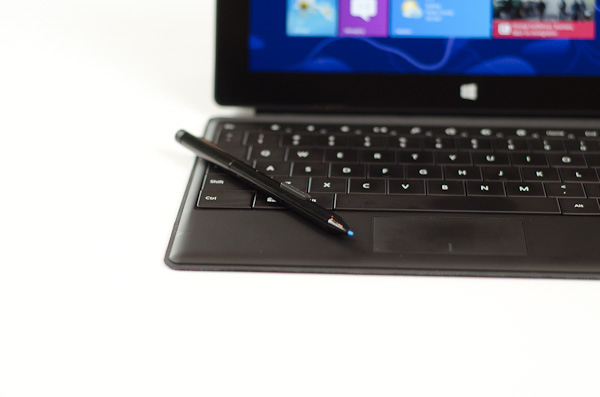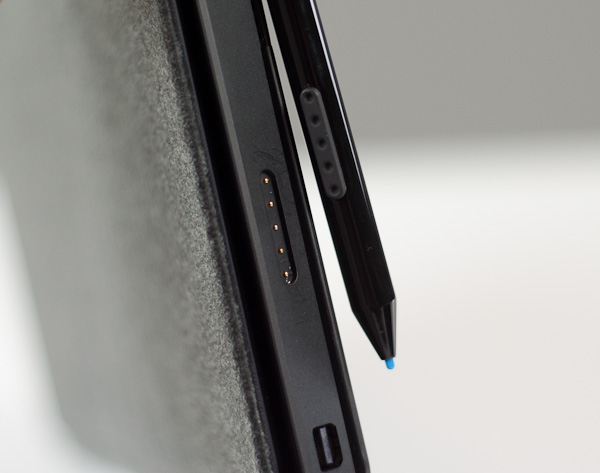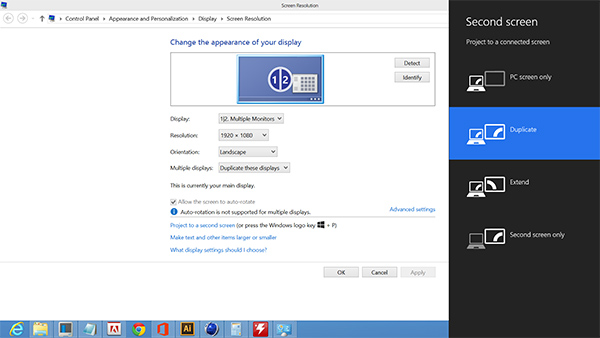Microsoft Surface Pro Review
by Anand Lal Shimpi on February 5, 2013 9:00 PM ESTThe Surface Pen
While you don’t get a keyboard with Surface Pro, Microsoft does bundle a digital pen with the device. Based on Wacom’s technology (presumably Electro-Magnetic Resonance), the SurfacePen supports 1024 levels of pressure sensitivity. The pen itself is passive, all of the power consuming circuitry is contained within the display stack itself. A weak EM field is generated by Surface Pro which enduces a current in the digital pen that then powers its resonance circuit, which in turn impacts the EM field and is used to determine the position and angle of the pen itself. Surface Pro will recognize the pen starting from about an inch above the display. The pen won’t work on Surface RT as the requisite Wacom EMR grid and logic don’t exist on that tablet.
It's not clear to me whether or not Microsoft is using Wacom's RRFC to enable capacitive touch in addition to digital pen support. Regardless, I didn't notice any impact on touch response when using Surface Pro without the digital pen.
The Surface Pro pen doesn’t store anywhere inside the device, but it can be docked to the magnetic power connector as long as you’re not charging the tablet. The magnetic dock doesn’t charge/power the pen in any way, it just holds it in place. The tablet is a bit awkward to hold with the pen in place, and there’s also the problem of where do you store the pen if you’re using the tablet while plugged into the wall, but I suppose it’s better than nothing.
Microsoft does a good job of palm rejection with the pen in use, although I did occasionally have to erase an errant line or two caused by the edge of my hand in a drawing app.
Tracking and responsiveness were both excellent in using the pen. I’m not much of an artist but I did have a good experience sketching with Surface Pro’s pen. Creative professionals who are already Wacom users will probably appreciate the inclusion. Surface Pro doesn’t really offer the same drawing surface area as some of the larger Wacom tablets, but I can see how it’d be a nice addition for those who don’t want to carry around a separate drawing tablet.
You can configure Surface Pro to work in second screen mode, allowing you to use the entire display as a pen surface while using the integrated miniDP out to drive your display to an external monitor. In this mode Surface Pro approximates a Wacom digital tablet, although without the software customization that you get with those tablets. The biggest issue I had in second screen mode is the lack of a toggle to switch between pen and mouse positioning, Surface Pro operates exclusively in the former.
In pen positioning, every point on the Surface Pro display corresponds to a similar location on your external display. To draw something in the upper right corner you need to move your pen to the upper right corner of the Surface Pro display and draw there. Wacom’s own tablets let you switch to mouse mode, allowing you to use the pen as a mouse to place your cursor wherever you want it. Pen mode is something you may or may not be able to get used to, but it’s worth pointing out that the inflexibility is a limitation of Surface Pro’s pen implementation.














228 Comments
View All Comments
netmann - Thursday, February 7, 2013 - link
Nice review Anand! It seems there is a lot of interest on this device. If you still have the unit can you please do a quick tear-down of the unit with pictures showing the cooling fans, SSD, memory, etc?Wolfpup - Thursday, February 7, 2013 - link
Fantastic review!Random thought I've had about Surface since it was unveiled...doesn't a keyboard dock like what HP includes with their Envy x2 make more sense than these touch/type covers?
I mean I get that some people use covers anyway, and leave them on (I don't on my iPad 2), and so you're sort of getting a keyboard always there for "free" for those people.
But at least judging by pictures, the touch and even type covers appear to be terrible keyboards, and look really awkward. The kickstand is nifty, I guess, but HP's Envy x2 (and some others) are basically giving you a normal notebook keyboard you plug it into, and it becomes almost indistinguishable from a notebook. That gives you a better keyboard, unlimited angles to put the screen at, and also makes it easier to sit it on your lap and type, if need be.
I haven't used either type of device yet, but from pictures it sure seems like a dock like that would be preferable to a type cover/pad?
This really is an interesting product though...I thought Apple needed to do this 4 years ago, like in place of what the iPad turned out to be, I was hoping it would be a real OS X PC running on Atom with an optional touch interface-basically exactly what Windows 8 ended up being.
I know these will get massively better even later this year with Haswell (or heck, Tegra 4), but I'm still so tempted both by Surface Pro and that Envy x2... (wish that used AMD's Z60 instead of Atom though). Hmm...an additional battery in a keyboard dock could double Surface Pro's battery life too...
And yeah, to me it seems like this ought to come with a type cover. I can understand and accept the price-this is an actual PC running hardware that runs circles around an iPad that's only marginally cheaper-but somehow it just seems like these things should be including keyboards.
TidalWaveOne - Thursday, February 7, 2013 - link
"f you’re shopping for an Ultrabook today and want that tablet experience as well, Surface Pro really is the best and only choice on the market."There is at least one other device for that ultrabook/tablet experience... the Dell XPS 12. I have one on order... there are also more, like the Lenovo Yoga.
Death666Angel - Thursday, February 7, 2013 - link
Different designs in my opinion. The Dell has the burden of always carrying around that keyboard, which means you have a 1.5kg tablet. The CPU, RAM and storage options look pretty good on that. But it lacks a digitizer which might or might not be a huge deal for you. Same thing with the Yoga. Very big (13.3"), low-ish resolution (900p), always a keyboard attatched, no active digitizer. Again, these things might be important enough to make the devices pretty much distinct categories. Or you just want "laptop-ish, touch screen, Core CPU" then they are all comparable. :DThe closest things to the Surface Pro in my mind are:
- Lenovo Helix: 11.6", 1080p, keyboard dock, active digitizer, 3G
- Samsung Ativ PC Pro: 11.6", 1080p, keyboard dock without battery, active digitizer, 3G
With the Lenovo being my dream device, because of the battery built into the keyboard dock mostly. But the dock design is fairly cool, too. :D
travelster - Thursday, February 7, 2013 - link
Almost two years ago I picked up an ASUS EP121 10 inch Tablet. It came with an i5 processor and Windows 7. I now have Windows 8 on it. Win 7 and 8 runs extremely well, as does Word, MS Project, VMWare, RDP, and all other apps I can run on Windows desktops and laptops. I.e. The Surface Pro's grand vision of a full-service Windows tablet was old news even before long it was released!Glenn Rogers
DBGallery Product Manager
sn_85 - Thursday, February 7, 2013 - link
After playing around with this at the Microsoft Store today I came away feel like it was a mixed bag. I feel the build quality is really impressive and I have no qualms about the unusual nature of it's kickstand and keyboard covers. It just feels like a wonderfully solid design that takes on a more business like approach with it's VaporMg and straight line design. Honestly I just wish it came in the form factor of the Surface RT because what a difference a half pound and 3.5mm can really make. The thick form factor and weight just make it much more cumbersome to hold and I wouldn't see myself holding this thing in one for two long at all. Before anyone calls me a weight weenie you really just have to hold it in person and compare the Pro the RT before make a statement, it's a pretty significant difference. I hope the next iteration takes on a diet and comes closer to the form factor of the Surface RT because it still retains the impressive build quality without all the thickness and weight.Battery of course is another area of concern. If this thing got closer to 6-7 hours like some of the longer lasting Ultrabooks it would be a real winner IMO.
The price I feel is fine but the keyboard covers need to be included in the price. I know it's a unique design but there is no reason for MSFT to be nickel and diming here, especially in the case of the Pro. Fact is anyone looking at this device will buy either one of the Touch or Typecovers but to just spend another $120-$130 on it is excessive.
Ultimately I think this device is what most reviews say, you can see the tremendous potential and it is impressive in it's own right. It just misses on a few key things that keep it from being a product that is universally recommended as opposed to what it is right now where you need to know what you're getting into. I feel just like Anand on this, the Surface Pro 2 is simply going to be an awesome product. One that I'd buy on launch day. That being said I still might get this Surface Pro until that time comes.
sirnumbskull@gmail.com - Friday, February 8, 2013 - link
Can you verify whether or not the Surface Pro has Widi support?Kornfeld - Friday, February 8, 2013 - link
WiDi is an Intel technology that requires, among other things, supported Intel WiFi adapters. Since Surface Pro uses a Marvell WiFi adapter, it cannot possibly use WiDi.The real question is whether it will support Miracast which is the larger spec being adopted by the WiFi alliance. I'm not sure if that specific adapter supports Miracast. I found this press release, but I'm not sure about the part numbers: http://www.marvell.com/company/news/pressDetail.do...
The bigger problem with Miracast right now is that there doesn't seem to be any connection software available for Windows. So, I'm sitting around with a Yoga that has a Miracast supported WiFi adapter and I have the latest Netgear device that supports WiDi and Miracast, but no application that can be used to connect to the device.
toyotabedzrock - Friday, February 8, 2013 - link
Looking at the pictures it becomes apparent that they did not pay enough attention to small details. The random 5 pin connector looks ripe for problems. And sticks out like a soar thumb.The display resolution is too low on both models. And there is no excuse for the small batteries.
It seems as if the execs at these PC companies eyes are failing them if they have not noticed these things.
redSn0w - Friday, February 8, 2013 - link
Just wondering if Microsoft could have gotten better battery life by using a Core i3 or even some pentium/celeron derivative. The way i see it, the 3 main drawbacks are the price, battery life and thickness/weight of device. So, maybe using one of the aforementioned processors for the first generation product would have helped. And, they could have moved to Core i5 when Haswell started shipping.I seriously doubt that any power user could replace their notebook/desktop with a Surface pro unless you could dock it to a bigger screen and a proper keyboard. As for the regular users i don't think too many of them would even be interested in a product like this when an iPad works for them.
Anyways, i'm still going to go check it out tomorrow but most likely i'll wait for the next generation product (if it's ever released).